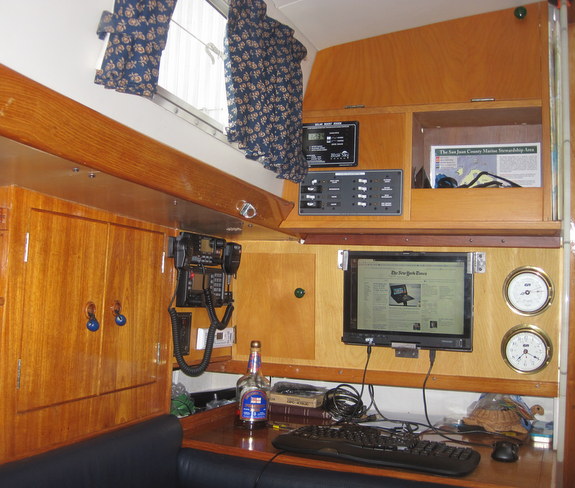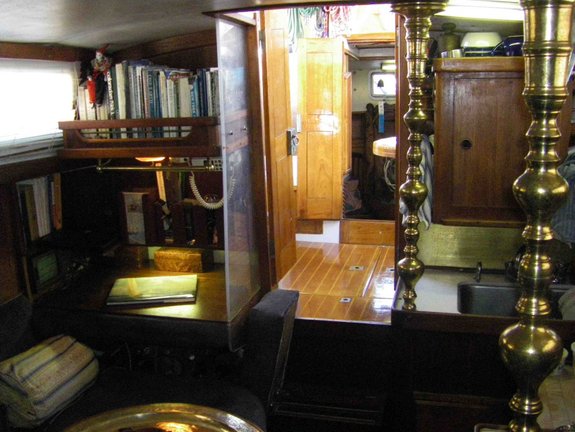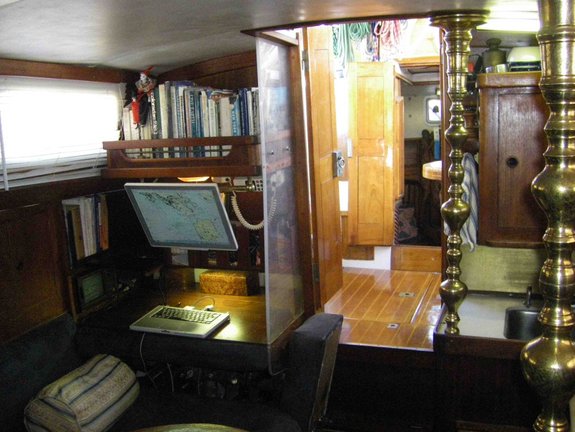Welcome Back › Forums › House Systems › Electrical › Main saloon instrument panel
- This topic has 11 replies, 5 voices, and was last updated 3 years ago by
 Moderator.
Moderator.
-
AuthorPosts
-
June 10, 2013 at 20:40 #6541
 John TylerParticipant
John TylerParticipantI have a Nic with the usual instrumentation, but no main panel in the saloon. The various instruments [VHF / SSB / AIS / depth / etc have all been added individually at various times. What main panels have other people installed to switch on and off different bits of kit? There are plenty on the market. It would help to know which type have been added by other owners.
Cheers
John [Aquarius Nic 100]June 13, 2013 at 14:43 #13721 ModeratorKeymaster
ModeratorKeymasterI’m posting Jeff’s response here, to keep this topic together. His original response is under “The value of Nic 38’s”. I’m also including the photos that Jeff mentions below.
– moderator –Quote:Hi there John,
I had the nav-area re-designed in ’07 & ditched the old fuse-panel. New one is a Blue Sea Systems Circuit-breaker panel with the trip-switch panel on the bulk-head underneath the chart-table, & you could choose any size of C/b panel to suit your requirements. Excellent brand & well made. I should have bought a larger panel though, with enough spare switches for future installations. As it is, I have to connect new equip’t onto terminals that are being used already which I’m not altogether happy with, but space was an issue at the time the new panel was bought.
I’ve just taken 2x photos for you, which Marilyn may be kind enough to post on for me.
Regards,
Jeff
June 14, 2013 at 02:07 #13731 VanParticipant
VanParticipantHi John, I redid the panel as part of a major overhaul of the wiring on Rainshadow. This was definitely a worthwhile, though time consuming project. Most importantly, it gave me the chance to implement a number of safety features.
Thinking just about the panel, replacing it does give you the chance to make sure the fuses/breakers are sized correctly for the wires and devices they support. The original wiring (rather, the wiring we inherited from the previous owner) was not fused correctly, some very small wires having large breakers, and more than one wire was not fused at all.
I gave a lot of thought to the panel, and considered the same panel Jeff used, but in the end I opted to rely on fuses to protect wires at a very granular level that I could not get with breakers. In other words, essentially every wire on the boat now has its own dedicated appropriately sized fuse, and the wires are grouped together into “circuits” protected by one of eight 15A breakers. When I did this, it turned out that I only needed eight circuits: 1) Cabin lighting and such, 2) the Refrigerator, 3) the Radar, 4) the Webasto diesel heater, 5) Running lights, 6) Sailing instruments (like knotmeter), 7) the Helm and 8) the Nav station (chart light, computer, etc).
The fridge, radar and heater are on dedicated circuits.
I placed the panel in an instrument box I made above the nav station (there was originally a smaller one). In the recessed location where the old panel went, I placed two fuse boxes, each holding twelve fuses. One fuse box serves circuit 1 (Main) and one serves 5 (running lights). There are also fuse boxes under the nav station for 8), and one in the instrument box above to serve 6). Finally, the helm 7) has a fused switch box (waterproof) under the wheel. So, apart from the three dedicated circuits, every circuit has an associated fuse box, and plenty of spare capacity.
I replaced the switches for the nav lights with new ones, but they remain in the recessed location where the old breaker panel was.
The bilge pumps are on a dedicated circuit, directly connected to the house batteries (fused of course).
Finally, there are several weird items, like the input to the batteries for the solar panels, and the engine hour meter, etc that should not be on a circuit breaker that someone can turn off, but nevertheless need fuses. I added a dedicated fuse box in a container in the stb cockpit locker on the bulkhead shared with the nav station.
I thought about writing this up in more detail in our web site svrainshadow.com, but have not got around to it – however this gives the flavor of what I did, and the main motivation.
Everything has worked fine for the last year.
Almost all the components are Blue Sea Systems.
Good luck!
Van
 June 14, 2013 at 05:15 #13741
June 14, 2013 at 05:15 #13741Orion
ParticipantHi John
I like reading these variety of solutions, you’re getting. On Orion I chose the middle path. I’ve tried to preserve the original equipment, where practical. I’ve retained the original, though quaint, fused wire panel. It’s been repurposed, to handle only house lighting and fans. Since I use mostly fluorescent tubes and LED bulbs, the old box handles relatively low amps.
The box has been moved several inches inboard, on the same bulkhead, making room for a new breaker panel next to it, on the outboard side. The new panel is only slightly recessed, and is not readily visible, from the saloon.
This panel handles all the mechanical functions..breakers for things like refrigeration, and autopilot, 12v outlets, service pumps, et al, as well as breakers for a couple of busses to remote sub panels. There’s a switch panel for the running lights and deck spotlights adjacent to the binnacle, and a fuse panel, in the binnacle’s base, for all the steering station instruments and lighting. On Orion, the VHF, depth, small chartplotter, AIS, and radar are on or in the binnacle, along with the autopilot panel.
On the narrow panel, under the chart table, are three battery switches, a 5-input voltage gauge(3 batt banks, charger/alt output, solar/wind regulator output), inverter controls, and a charger source distribution panel, that allows simultaneous pairing of one of the three charging sources, with any battery bank.
The bilge pumps and 8″ school bell alarm, have a direct, fused connection to a house battery. There’s a fourth battery, a small 24 group, with its own mini panel, that acts as a short term backup, for the refrigeration, and bilge pumps, only.
The additional breaker panels, fuse blocks and switch panels are all Blue Sea Systems, with a couple of Marinco and West Marine brand thrown in. I’d stick with Blue Sea, where possible.
The most important safety feature of Orion’s electrical upgrade, is the elimination of wire bundles that contain both positive and ground wires, particularly duplex wires. This eliminates the possibility of wire jacket disruptions causing a dangerous short.
I hope there are a few useful ideas in there.
michael
June 18, 2013 at 08:54 #13821 John TylerParticipant
John TylerParticipantThanks to Jeff, Michael, Marilyn & Van for your info & photos.
I enclose one of Aquarius‘s [old-school]nav station for your entertainment. I hope to upgrade it soon, altho it all works OK.
Cheers
John(Moderator – at John’s request, I am editing this post to say he has a new panel and it no longer appears this way. March 2018)
July 27, 2013 at 01:16 #13881Orion
ParticipantJohn,
The differences can be stunning. Aquarius’s nav table is all business. When you mentioned “old school”, I was expecting the 50 year-old B&G instruments, Orion still had, when I found her. Here’s a contrast, for you..Orion’s nav and engineering table. When I purchased Orion, my friends, fellow racers in hi-tech J-105 and Farr 40 classes, teased me about being the owner of a “furniture boat”. I decided to embrace the moniker. Here, the computer screen can be tipped up, or relocated to the aft cabin, entirely, where there is also a NEMA patch. All the radar, chartplotting, auto-pilot control and engine monitor software, are on both laptops. (that’s the spare, off to the left) Of course, this is all a generation old, already, as many boats have WiFi and totally portable tablet controller/plotter/monitors. (My boat still requires me to hoist and trim the sails, for it.)
Note: That’s a book about the pre-war J-boats, on the table. It features the Charles Nicholson designs, from the Shamrocks, to the Endeavours. (I’ve seen Shamrock V race, informally, against two other remaining J’s)Regards,
michael
Orion
(hopefully Marilyn can add the photos)August 4, 2013 at 05:49 #13921 ModeratorKeymaster
ModeratorKeymasterHere are the photos that michael sent me for posting. See the above reply for descriptions.

 April 8, 2021 at 18:01 #26902
April 8, 2021 at 18:01 #26902Rhapsode
ParticipantI’m a few years late to this party but it’s time for me to bite the bullet and rewire the boat.
I’m wondering how you got on John with your old equipment. When you updated your electrics did you keep the equipment or replace it with modern slimline kit? Rhapsode still has the original and bulky B & G echo sounder which works well. I don’t want to replace a perfectly good instrument but I would like a clutter free panel over the chart table. I’m wondering whether to follow Van’s example but bring the panel above the chart table out by about 8cm all the way down. That way I can hide things like the AIS unit and MPPT controller behind it to de clutter and cut a hole for the echo sounder so that the face is flush with the new panel. Has anyone considered this option? Critiques very welcome.
Thanks,
April 11, 2021 at 22:26 #26903 VanParticipant
VanParticipantWe are pretty happy with the way we did it on Rainshadow, which was to build a small cabinet up above the nav table. You can see it in the photo in my earlier comment. It is about 30cm tall and 15 cm deep, and in two sections.
The upper section contains three instruments that face into the cockpit through the bulkhead (Fishfinder/Depthsounder, Speed Thru Water, and Wind (latter two are Datamarine, quite old but working). It also contains the AIS box, and a data multiplexer that links the NMEA 0183 instruments to the NMEA 2000 network. So, it’s crowded up there, especially with the wiring necessary for all that.
The lower section has the main circuit breaker panel, and also room for a solar controller.
The BIG mistake I made was that I did not provide a large enough conduit for the wiring to get down to the main wiring area behind the original breaker box.
It’s not nearly large enough as over the years we have added more and more stuff (like the N2K network, additional transducer cables, AIS, USB…..). Worst, most of these cables have sizeable connectors, which barely pass through the remaining space.
Extending the cabinet all the way down like you are proposing for Rhapsode seems like a great idea, because you will have lots more room for wires and devices. Just make sure 8cm is deep enough.
Oh, and it is also really easy to drill through the bulkhead into the cockpit by accident…..
Van
April 14, 2021 at 20:20 #26905Rhapsode
ParticipantThanks Van – very useful advice. What would you estimate the thickness of the bulkhead to the cockpit to be?
I should have started this project years ago – I’m hauling out old wires by the armful with barely a fuse in sight!
I’ve decided to upgrade the the instruments after all. So if anyone wants the original B & G echo sounder and wind instruments’ controller let me know. I’m also removing the original Neco system so I’m happy to take those home with me as well if they are of use to anyone. We’re in Grenada at present so we might not get back to the UK for a few weeks yet.
Peter
April 16, 2021 at 12:18 #26906Rhapsode
ParticipantDoes anyone know where the wire from the aft heads light reappears after going up in to the deck head?
March 9, 2022 at 02:59 #27092 ModeratorKeymaster
ModeratorKeymasterI’m adding to this on request from Peter Greenhow, owner of Rhapsode. Photos show an impressive rewiring job!
Peter says:
Thank you to everyone who has gone before me – I found everything posted very useful in helping me develop my own design.
There is an entirely new panel ten centimetres forward of the old one. This gave me enough depth to fit the instruments I didn’t need to see on a regular basis – AIS, MPPT battery charge controller (I use the Victron app to monitor the charge controller) and the transducer converter (we have Raymarine instruments).
In addition to the Blue Sea panel inside there is a weather proof panel in the cockpit with breakers / switches for nav lights in all their variations, spreader lights which I changed to LEDs, Echomax, Autopilot and cockpit light. The bilge pump has its own circuit.
The SSB is to the side of the main panel and is recessed so that the knobs don’t protrude which allows the chart table lid to open fully albeit not quite as far as in the original arrangement.
Although we don’t normally spend much time in marinas I changed the very old Sterling battery charger for a modern version and found it considerably more efficient.
Peter


-
AuthorPosts
- You must be logged in to reply to this topic.